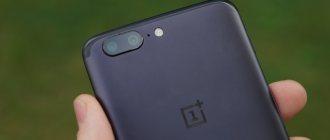OnePlus does not change its habits and once again presented a “modified” version of its latest model, adding the suffix “T” to the name. Albeit with some delay, OnePlus 6T has finally reached our editorial office - let’s see how it differs from the “six”.
OnePlus 6T line Smartphones and mobile phones on
Models in the line: 3
Price range: 10,999 − 16,305 UAH
Equipment
In a fairly large box, in addition to the smartphone itself, you can find a silicone case, a charger, a USB Type-C cable, a clip for removing the SIM card tray and a short adapter from USB Type-C to a mini-jack - for connecting to a “regular” smartphone. wired headset.
Design
When the screen is turned off, the OnePlus 6T is minimally different in appearance from the “six” (plus or minus 1-2 mm in the body dimensions does not count): glass front and back panels, aluminum frame, smoothed corners. The device is offered in two black versions (the “white and gold” version, which was on the OnePlus 6, is absent on the 6T): with a glossy back side Mirror Black and with a matte back side – Midnight Black. In addition, there is an exclusive McLaren Edition in Speed Orange - also with a high-gloss rear panel, but with a subtle carbon pattern and side edges that reflect McLaren's signature papaya color.
Our editorial team visited the first option - Mirror Black, and as in the previous review, we can state that the gloss turns out to be very slippery, so a protective case with matte non-slip ribs comes in handy here: the smartphone in it feels noticeably more slippery in your hands. dimensions, but you hold it much more calmly - it will no longer be able to slip out of your palm.
On the top edge there is a noise reduction microphone and a speaker, on the left side you can find a volume rocker and a SIM card tray, on the right there is a power button and a proprietary lever for switching notification modes. On the bottom edge there are a USB Type-C connector and holes for the multimedia speaker - but in the end it followed the fashion and also removed the mini-jack (instead, offering an adapter included in the kit, plus introducing the branded Bullets headset with a Type-C connector, which can be purchased separately for $20).
The back panel looks almost like the OnePlus 6 - a dual main camera module in the center and a flash below it, with one exception - the 6T does not have a fingerprint scanner (where it went - a little further).
After turning on the smartphone, one of the main differences from the previous model becomes noticeable - the screen has become a little larger, but the main thing is a radically reduced cutout in the upper part, for the front camera; If earlier it was a full-fledged “unibrow”, then the 6T has a teardrop-shaped cutout (the barely noticeable slot for the earpiece, which was previously located here, has been moved upward in the 6T, to the joint between the screen and the side edge).
It should be noted that when using a smartphone, such a cutout is much less of an eyesore, so users who cannot stand the “unibrow” will most likely be able to put up with this “drop” and will not turn on the notification panel coloring black ( Traditionally, this option, which allows you to visually hide the presence of a cutout, is present in the settings). The only drawback of this cutout is that there is no place for an LED indicator.
Screen
The screen diagonal has increased to 6.41 inches. This makes the device excellent for viewing multimedia, mobile photography and games.
The resolution is still Full HD. It provides high clarity and good colors. It's only when viewed from high angles that these colors begin to deteriorate.
As with its predecessor, the new smartphone supports the DCI-P3 color range. In the settings you can select other color ranges, such as sRGB.
There is also a night display mode with dark colors and monochrome for reading. This is an AMOLED panel with traditionally high contrast and deep blacks.
There is no support for HDR mode on OnePlus devices yet. Perhaps this has something to do with the brightness of the screen. There are no particular problems with viewing the contents of the screen in the sun, but there are smartphones that are brighter.
When adaptive brightness is turned on, the device often sets the brightness level too low. If this is not a problem with a specific device instance, I would like to get a software update. As for HDR, we should count on its appearance in future models.
OnePlus 6 became the first smartphone from this manufacturer with a notch on the screen. This time the neckline has been reduced in size and looks more tolerable.
Like the Oppo F9 and Huawei Mate 20, the teardrop-shaped cutout houses the front camera. Here it has a resolution of 16 megapixels. There is a speaker nearby.
Facial unlocking is supported, which works using a single RGB camera. This means it's not as advanced as the infrared dot projector system found on the iPhone XS. However, there are other authorization methods besides facial unlocking.
This is one of the first smartphones with an in-display fingerprint scanner. An image of a fingerprint appears on the screen, to which you must press your finger firmly. After this, the device will be unlocked.
It sounds interesting, but the implementation is not ideal. The technology is just nascent, so it's not OnePlus' fault. Regular fingerprint scanners on previous smartphones are faster, but they're unlikely to make a comeback.
The new optical scanner is less reliable than the previous ones, but it brings with it the feeling of advanced technology. You can customize the animation that accompanies the unlocking process. There will be a special menu that opens by holding your finger on the screen during the unlocking process.
Fingerprint's scanner
Starting with OnePlus 5T, the fingerprint scanner “moved” to the rear panel - the smaller frames no longer allowed it to be installed in front, under the screen. Not the best solution for a fairly large number of users who find it more difficult to feel it blindly - maybe for this reason, or maybe just for the sake of an additional item in the list of differences from OnePlus 6, but the manufacturer decided to move the scanner back to the front panel. And since there was no more space under the screen, we had to... build it directly into the screen.
The sensitive area is illuminated with a pattern symbolizing a fingerprint when you take the smartphone in your hand or simply “tap” on the screen - after that, just put your finger on it, and in a split second the smartphone will be unlocked. This is not the first smartphone with a fingerprint scanner built into the screen, but it is definitely the fastest - the recognition speed is not much lower than that of conventional scanners. An optical sensor is used here, so in theory the scanner needs light to “read” the finger - however, it also works in complete darkness, for one simple reason - at the moment of touch, the screen in this place turns on a bright backlight (which can be seen if you move it a little finger to the side."
The only inconvenience that we encountered during operation, and which is typical for all smartphones with an optical scanner of this type, is the problem of using it in the cold, or more precisely, recognizing cold fingerprints; Depending on how cold your hands are, this procedure may take significantly longer (up to several seconds) or may not take place at all.
Display
The screen of the OnePlus 6T has become slightly larger - 6.41″ versus 6.28″ for the OnePlus 6; Both the proportions and resolution have changed: the new product has become a little elongated (19.5:9, not 19:9), which added pixels in height (1080x2340 versus 1080x2280). The pixel density ultimately remained the same, ~402 PPI. The main difference, as already mentioned, is a different type of cutout: by placing the earpiece not next to the front camera, but above it, the manufacturer managed to significantly reduce its size, so that now it is almost not noticeable. Protective glass - Gorilla Glass 6 (OnePlus 6 had Gorilla Glass 5), the screen out of the box is covered with a protective film.
Brightness ranges from 1.7 to 410 cd/m² - the maximum value here is slightly lower than that of the OnePlus 6. In the phone settings (Display – Screen Calibration) you can switch between different video modes: “standard” offers the maximum color gamut, however its color accuracy is not the best, and by default the screen has a cool tint. You can fix this by using “custom color” or “night mode”: they allow you to make the image warmer using the temperature slider.
Standard mode:
In addition, there are sRGB and DCI-P3 modes that emulate the corresponding color spaces, and in them the color temperature adjustment and color accuracy are much better. Although the color saturation in them is, of course, lower (especially in sRGB) - some will not like it, because it is “too faded”, for others, on the contrary, the picture will seem calmer, without too “flashy” colors and more similar to the one that can be seen on the IPS display.
DCI-P3 mode:
sRGB mode:
Outdoors, the screen predictably fades, but in cloudy or even cloudy weather at maximum brightness it remains quite bright, with rich colors - and even in direct sunlight it is still possible to read the information on the screen.
OnePlus 6T A6010 8/256GB
6.41″ Snapdragon 845 8/256GB
Data updated 10/02/2020 07:35:15.
| Salesman | Orders | Midnight |
| ChuangMei | 4 | |
| ChuangMei | 24 | |
| ChuangMei | 30 | |
| ChuangMei | 17 | |
| Pophong | 2 | |
| Tommao | 0 | |
| VSTAR | 1 | |
| YTDC | 22 | 379.26 |
Hardware platform, performance
In this regard, OnePlus 6T is practically no different from its predecessor: it also uses the Snapdragon 845 SoC (octa-core CPU, 4 cores running at 2.8 GHz, and four more at 1.7 GHz, plus Adreno 630 GPU), and RAM can be 6 or 8 GB. Only the amount of internal storage has changed: now it is 128 or 256 GB (the second option is only in a configuration with 8 GB of RAM).
The smartphone has NFC, Bluetooth 5.0 with support for the aptX HD codec, dual band Wi-Fi and other standard sensors. Like previous models, USB Type-C here works according to the USB 2.0 standard.
Accordingly, there are no significant differences from the OnePlus 6 in the benchmarks; in terms of heating, they also behave similarly - the body becomes warm under artificial load, but in real operating conditions this is almost not felt.
OnePlus 6T A6010 6/128GB
6.41″ Snapdragon 845 6/128GB
Data updated 02.10.2020 07:14:41.
| Salesman | Orders | Mirror |
| ChuangMei | 4 | 337.86 |
| ChuangMei | 24 | 345.86 |
| ChuangMei | 30 | 338.86 |
| ChuangMei | 17 | 339.19 |
| DHYUAN | 4 | 342.75 |
| Tommao | 0 | 549.88 |
| YTDC | 22 | 347.99 |
Software platform
OnePlus 6T uses the proprietary OxygenOS shell (at the time of writing the review, the latest stable version was 9.0.11, based on Android 9).
OnePlus remains true to its traditions - its shell looks almost like “pure” Android, but offers additional functionality, proprietary widgets and advanced settings, while it works very quickly, smoothly and without the slightest stutter. Among the main differences in the interface, we can mention a special screen on the left, containing blocks such as recent applications and contacts, and you can also add regular widgets here.
The transition to Android 9 did not make any fundamental changes to the Oxygen interface, however, a number of menu items were noticeably redesigned: for example, the list of running applications now looks “like on iOS”, information about the battery status was supplemented with comments in the spirit of “the phone is used more than usually” and “the charge will last until about 23:00”, and the “about phone” window has received a complete redesign.
Cameras
OnePlus has been amazingly persistent in terms of the configuration of the main cameras - starting with the 5T, it equips its smartphones with a system of two color cameras with the same focal length. The 6T uses a 16-megapixel main module (Sony IMX519, 1/2.6″) and a 20-megapixel secondary module (Sony IMX376K, 1/2.8″); their maximum aperture and equivalent focal length are the same - f/1.7 and 25 mm. Optical stabilization of the main camera, which disappeared from OnePlus smartphones for some time and returned in the “six”, is also present here.
The camera interface has not changed much; it is still simple and intuitive and not overloaded with unnecessary settings (however, in Pro mode, fans of manual adjustments will be able to find everything they need). Swiping left and right on the viewfinder switches the camera between video/photo, portrait and night modes, swiping up brings up a menu with additional modes: slo-mo video (fps, fps), panorama, time-lapse shooting and Pro mode.
In sunny weather outside, the camera takes excellent pictures, with good dynamic range and natural color rendition. The color saturation may seem a little too high, but it is not at all critical. The built-in noise reduction behaves very aggressively even in such ideal conditions: when looking at pictures on the monitor and at 100% magnification of the image on the grass, tree branches, etc. the result of his work becomes clearly visible, the detail there noticeably suffers. In cloudy weather, color saturation is expectedly reduced, but otherwise the quality of the images is at the same level.
Indoors or at dusk outdoors, the quality decreases quite slightly; night shots also generally look good, although here the noise reduction works even more actively, which is why detail is further reduced.
Night mode can further improve image quality: the frames it takes show slightly more dynamic range than those taken in standard mode, plus when using a tripod, you can achieve greater clarity and detail. However, it should be used with caution - bright objects in the frame can be “muted” to an unnatural state, which will ruin the entire photo.
On the left is a regular photo, on the right is night mode:
The HDR mode, the behavior of which was rather strange in the OnePlus 6 (at least at the time of writing the review), and which we then recommended using with caution, works quite correctly in the 6T: in most cases it does not spoil the image, but on the contrary, allows you to highlight Shadow details in a high-contrast scene that would normally appear too dark due to insufficient dynamic range.
On the left is a regular photo, on the right is HDR:
If we compare it with OnePlus 6, we can note that the 6T has slightly increased the saturation of the pictures - in the previous model they look a little more faded than in the 6T. In general, we liked the photo quality of the OnePlus 6T - it is inferior to the top camera phones of competitors, but not catastrophically, and overall it looks adequate for the price of the smartphone.
⇡#Camera
The set of cameras has not changed at all compared to OnePlus 6: there is a main 16-megapixel Sony IMX 519 sensor with an ƒ/1.7 aperture lens and an additional 20-megapixel Sony IMX376K with a lens of the same aperture.
Autofocus is hybrid; when using the main camera, a contrast method is used; when using the additional (portrait) camera, a phase method is used. Moreover, it has clearly been modified in software - the defect rate has dropped significantly. If previously it was necessary to do a couple of takes, regardless of the subject and lighting conditions, then the 6T almost always catches sharpness on the first try. The optical image stabilizer on the main camera has also been preserved, thanks to which (in combination with a fast lens) you can take high-quality pictures in the dark.
| On the left - examples of shooting with a wide-angle camera, on the right - with a 2x zoom | ||
The zoom, as on all OnePlus, starting from the fifth, is hybrid. The real difference in focal lengths between the cameras is 1.5, while the device software offers 2x zoom. There are noticeable losses in image quality, but whether they are related to compression or the difference in sensors is difficult to say. Although when shooting at night they are, of course, easily explained - the stabilizer does not work in this mode, which forces the camera to raise the ISO and, accordingly, sacrifice detail and fill the image with noise.
| OnePlus 6 camera app interface | ||
The interface has not changed - the same minimalistic menu with switching between modes by swiping. To the set of portrait mode with software background blur, manual mode with a virtual horizon line, interval and slow-motion video shooting, a night shooting mode has been added.
| On the left is a picture with default settings, on the right is with night mode activated | ||
In it, OnePlus 6T stitches together several photographs taken with different exposures, thereby achieving an even distribution of highlights and shadows in the frame. But it slightly overdoes it with the software enhancement of detail - this is the fault of the 6T software in general, but in this mode it is somehow very pronounced.
Example of a portrait with software background blur
OnePlus does not make sudden moves in working on the cameras of its smartphones, using the same schemes in several generations of devices in a row, but gradually improving them. Now these improvements have affected the software part - and affected autofocus and the newly introduced night shooting mode. However, since both of them arrived with updates to OnePlus 6, there is no need to talk about the superiority of the 6T over its predecessor in terms of shooting quality - they have parity. But in comparison with its direct competitors, the next OnePlus looks very confident. Among the shortcomings, it is worth noting only a mediocre dynamic range, too hard work on increasing contour sharpness (especially in night scenarios) and software background blur in portrait mode that is slightly inferior to the level of A-brand smartphones. If compared with Xiaomi Mi 8, then the photo module of OnePlus 6T should be recognized as the winner. Not to mention the Pocophone F1.
Gallery of pictures
View all images (37)
Video recording is carried out with a maximum resolution of 4K at a frequency of up to 60 frames per second. Electronic stabilization is available when shooting in Full HD resolution.
| On the left is a regular selfie, on the right is with software background blur | ||
The front camera has not changed: 16-megapixel sensor (physical dimensions - 1/3.0''), lens with ƒ/2.0 aperture. Autofocus and flash are not provided. The minimalism that OnePlus adheres to in many areas also affects the possibilities for shooting self-portraits - there are no masks or Animoji, and retouching can be easily disabled by pressing one icon. The quality of shooting for a selfie camera is very good.
Autonomy
OnePlus 6T is equipped with a non-removable lithium-polymer battery with a capacity of 3700 mAh - this is not much more than the OnePlus 6 (3300 mAh), but in terms of autonomy, the new product shows noticeably better results. So, if the “six” lasted only a little more than 7 hours in the PCMark battery test, then the 6T lasted two hours more under similar conditions. Depending on the intensity of use, the owner of the OnePlus 6T can easily count on one and a half to two days of work on a single charge, and even with active use, he will most likely survive the daylight hours.
4.5
ITC.UA rating
Pros: Excellent screen; top characteristics; fast software; high quality images; minimum cutout size for the front camera; built-in fingerprint scanner
Cons: Very slippery body; possible problems with the fingerprint scanner in the cold season
Conclusion: As before, the model with the “T” index turned out to be a slightly “modified” version of the smartphone released six months ago. The same hardware platform (and increased internal memory), generally the same design - plus a significantly smaller notch in the screen and a fingerprint scanner built into the display. The quality of the images has improved slightly; it is also worth noting the increased battery capacity and noticeably increased autonomy. In general, if the absence of a mini-jack and an LED indicator is not critical for you, then we would recommend choosing the new one from these two models.
Specifications
| OnePlus 6T 6/128GB Mirror Black 10,999 − 10,999 UAH Compare prices | |
| Type | Smartphone |
| Pre-installed OS | Android 9.0 + OxygenOS |
| RAM, GB | 6 |
| Built-in memory, GB | 128 |
| Expansion slot | — |
| SIM card type | Nano-SIM |
| Number of SIM cards | 2 |
| CPU | Qualcomm Snapdragon 845 + GPU Adreno 630 |
| Number of Cores | 8 |
| Frequency, GHz | 4x2.8+4x1.8 |
| Battery | Li-Pol, 3700 mAh (non-removable) |
| Diagonal, inches | 6,41 |
| Permission | 2340×1080 |
| Matrix type | Optic AMOLED |
| PPI | 402 |
| Dimming sensor | + |
| Display Features | 2.5D Corning Gorilla Glass 6, 19.5:9 aspect ratio, frameless |
| Main camera, MP | 16+20 (f/1.7) |
| Video shooting | 4K (30 fps) |
| Flash | + (double LED) |
| Front camera, MP | 16 (f/2.0) |
| Camera Features | 16 MP – Sony IMX 519 and 20 MP – Sony IMX 376K, PDAF; “artificial intelligence” - the smartphone recognizes scenes with automatic selection of optimal settings for the best result |
| Communication standards | GSM 850/900/1800/1900, WCDMA Band 1/2/4/5/8/9/19, LTE Band 1/2/3/4/5/7/8/12/13/17/18/19 /20/25/26/28/29/30/32/66/71 |
| WiFi | 802.11ac |
| Bluetooth | 5.0 |
| GPS | + (Galileo, Glonass, BeiDou) |
| IrDA | — |
| FM radio | — |
| Audio jack | + |
| NFC | + |
| Interface connector | USB Type-C |
| Height, mm | 157,5 |
| Width, mm | 74,8 |
| Thickness, mm | 8,2 |
| Weight, g | 185 |
| Protection from dust and moisture | — |
| Type of shell | monoblock (non-separable) |
| Housing material | glass/metal |
| Keyboard type | screen input |
| More | fast charging with Dash Charge technology (5V/4A), Face Unlock, in-screen fingerprint scanner |
OnePlus 6T A6010 8/128GB
6.41″ Snapdragon 845 8/128GB
Data updated 10/02/2020 07:27:53.
| Salesman | Orders | Mirror | Midnight | Purple |
| ChuangMei | 4 | 346.19 | 345.86 | |
| ChuangMei | 24 | 339.88 | 340.19 | |
| ChuangMei | 30 | 345.86 | 345.86 | |
| ChuangMei | 17 | 345.76 | 345.53 | |
| DHYUAN | 4 | 354.15 | 354.15 | |
| overfight | 8 | 354.15 | 354.15 | |
| Pophong | 2 | |||
| Tommao | 0 | 339.88 | 339.88 | |
| VSTAR | 1 | |||
| YTDC | 22 | 347.99 |










